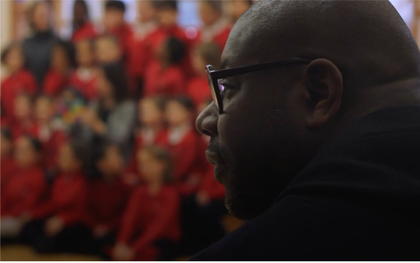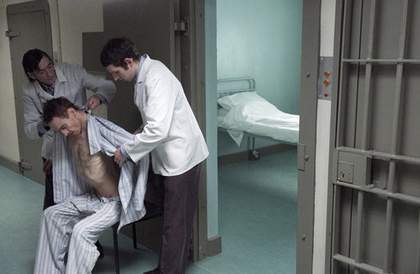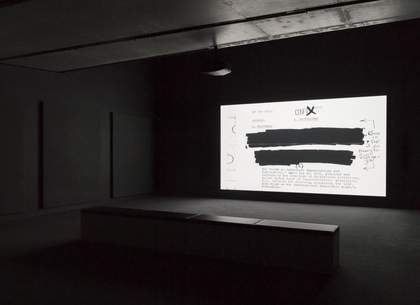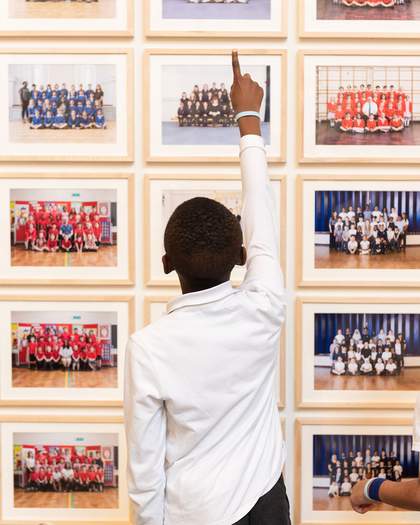
A child who participated in Year 3 spots his class portrait at Tate Britain
Photo © Tate
GARY YOUNGE Steve, we met almost exactly this time last year when Year 3 was being assembled at Tate Britain and were talking about what you thought it might do, and what it meant to you. Looking back on it now, how do you feel the project has gone?
STEVE MCQUEEN I was enthused by how many people knew about Year 3 and that it became such a talking point. So many people had strong personal connections to the work. It became about London, about the future.
GY Are you satisfied with the kind of conversations that it produced?
SM The conversations were at a level of engagement I could never have predicted. Education became a really important part of the conversation and the whole idea of the city; what London is, what London looks like and its future. When I was first in the Duveen Galleries, looking at all the photographs installed on the walls, it became apparent that Tate Britain was the only place where you could see a glimpse of the future.
GY I was really struck from the outset by the powerful simplicity of the idea – taking all year three kids, aged seven and eight usually, and putting all of the class photos of London in one place. When we last spoke you talked about the fact that in these photographs there could be a future prime minister, a banker, a bank robber and a kid who doesn’t even make 21… These lives are all in there, but we don’t know who they are yet. A viewer reflecting on their own life would inevitably go back to their own class photos. What about your own journey to this point, Steve?
SM My journey was very precarious, and I look back at my education with a sense of joy and real dread. I had a talent, and that was to draw. Art gave me my liberty. It was my life vest. Without my talent for drawing, I don’t know what would have happened to me.
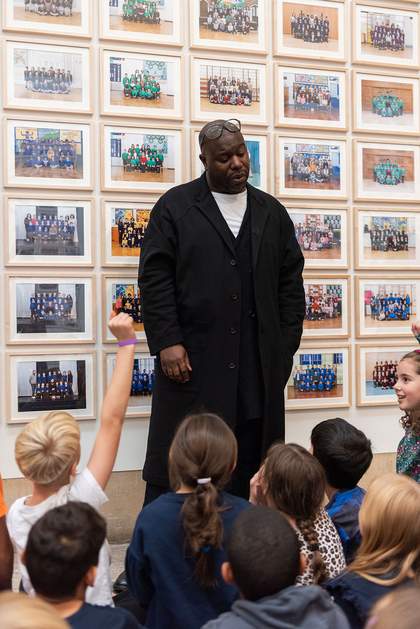
Steve McQueen with schoolchildren in Year 3 at Tate Britain, 2019
© Courtesy BBC London, Tate Photography
GY Something you said there, which really struck me, relates to the idea of unlikeliness. I think about how unlikely my life now would have felt to me when I was in my early 20s and already three times the age of the children in Year 3. Back then, I didn’t see the life that I have now. And here you are, with your accomplishments, and there is something about the unlikeliness of the conversation we’re having. It gives me hope when I look at those pictures. Who knows what conversations the children in the photographs might have in the future?
SM Exactly, that’s beautifully said, and who knows? I think that was the fuel for this project. I was a dyslexic child with a lazy eye, considered by my secondary school as fit only for manual labour. When I was 13 or 14, the school authorities put me in a ‘lane’ and that was going to be my lot – but it wasn’t.
So, if you look at the seven- and eight-year-olds in these class photographs, with various backgrounds and abilities, it is, of course, all about possibilities and how lives are shaped and formed. How much are our futures dictated by circumstances beyond our control?
GY Is there some kind of continuity between these photographs and your new film series Small Axe 2020, which is mostly, if not exclusively, about Black life in London?
SM There’s a reflection, yes. But it’s not just about the past – it’s very much about the future. It’s walking backwards and tracing one’s steps in order to have a better perspective on the future. I couldn’t have done Year 3 or Small Axe until now – I wasn’t experienced enough. I knew I needed to investigate places that I hadn’t previously, because they were complex and difficult to deal with. School was extremely painful for me. Even though I had the initial idea for Year 3 a long time ago, it took time to actually execute it.
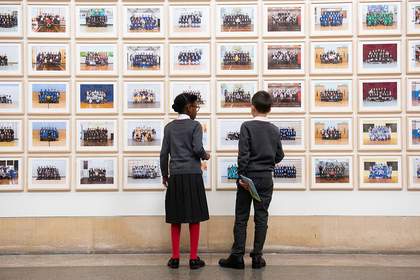
Schoolchildren in front of Steve McQueen's Year 3 at Tate Britain
Photo © Tate
GY When we spoke in November 2019 I asked, why year three? What is it about that year? And you said that it’s because it’s a time of limbo – it’s the first time that race, class and gender are introduced to them – and they have to grapple with these things. Little could we have known last year how much we would need to grapple with these things in 2020.
SM Absolutely.
GY And so, given the events of this year – the pandemic, Black Lives Matter, Marcus Rashford’s campaign for free school meals, the US election, Brexit – all of the things that have happened or that are happening, some of which we could never have predicted, I’m wondering: when you look back on 2020, what sense do you make of the project?
SM At its simplest, Year 3 is a cross-section through a particular time and place. It was an invitation to consider the children as they were when the photographs were taken – the past, present and future, all rolled into one. At Tate Britain the class photographs were arranged in neat columns and rows, from the floor to the ceiling. By standardising the format of the composition for each class photograph I wanted there to be a sense of equality, a level playing field for all these children, but ultimately it revealed the differences.
I think with COVID-19 and the Black and poor communities as well, we see the difference in how many people are being infected and how people are being treated. The Black community was deemed as being very vulnerable to COVID-19 and the Prime Minister of this country did not acknowledge that community in any compassionate or caring way. Then, during the Black Lives Matter situation, things were heightened and still not acknowledged in a right and proper way. In the sense of the school children and the trauma…
According to research, over two million children in the UK did almost no schoolwork during lockdown, and learning losses for children are feared – ones that affect the educational development of a generation. Who could have predicted that Year 3 would come to represent so much? The project has been very much in my mind during the times we are living in.
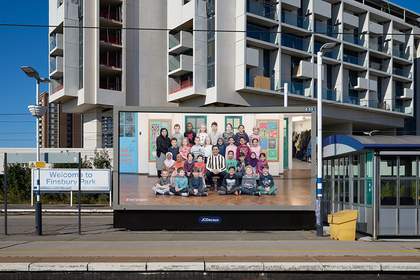
Steve McQueen Year 3 billboard at Finsbury Park station, London
© Steve McQueen & Tate, courtesy of Artangel, photo: Theo Christelis
GY A few months ago Lewis Hamilton broke the record for the most Formula One Grand Prix wins. He is from my hometown of Stevenage. I later saw that Stevenage Borough Council had decided to step in and pay for free school meals during the half-term holiday. What struck me was that, as Lewis Hamilton was being celebrated, there are kids in his hometown who are going hungry. I was on free school meals. And how do you create a future? Well, you look for potential and you invest in it. So, there is a degree to which we, as a country, may be knee-capping our future…
When I reread our previous interview for the Guardian in November 2019, I was drawn to your final quote. You said, ‘This is the future, they have to make it work – they don’t really have a choice’. I just wonder whether some people with influence don’t want to make it work?
SM One of the only reasons why I’m talking to you now is because there was an art teacher who gave me a chance. I applied for Chelsea School of Art but didn’t have the grades. At my interview, the head of the foundation course looked at my portfolio and was impressed. He said: ‘You can draw – that’s what we care about.’ He saw something in me and decided to let me in. The funny thing is, about 15 years later, he got in touch to ask me for a reference to go and teach in the United States. I reminded him of what had happened and, of course, I gave him a glowing reference.
GY The way that I have seen or experienced the Black Lives Matter period, is that there was this upsurge of awareness, and then there was this kind of pollination of confidence and militancy, and it landed in different places – in people’s places of work or unions or communities. Tracing the difference that it has made is difficult, but, in a range of ways, it has emboldened people. I know it’s in a different period of time, but maybe, like that guy who helped you, there are people around now that think, you know what, actually we need to do this, we need to take a bet on yes. When you were going into your foundation year in the late 1980s, it would have been during a pretty bleak time in British race relations…
SM Yeah.
GY …a time in which no one would have condemned that art teacher for not taking a bet on you. And yet that boldness comes from somewhere. Thinking about Small Axe, it comes from these small acts of defiance that are taking place all the time, and they feed off each other in ways we can’t predict and for people we don’t know.
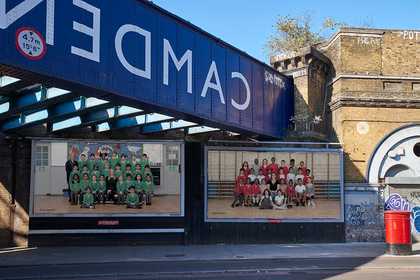
Steve McQueen Year 3 billboards at Camden Road, London
© Steve McQueen & Tate, courtesy of Artangel, photo: Theo Christelis
SM Ultimately, art saved me. That guy saw my portfolio, he saw the drawings and the possibilities and opened up a space to let them evolve. I mean there are no ifs, buts or maybes about it. You were talking about small acts of defiance; they may seem small, but they’re massive. That’s the thing about Year 3. In some ways, any small act of possibility, of defiance, goes a long way. We have no idea how the ripple effect will play out in time. I remember when you told me about you being with Nelson Mandela, accompanying him on his presidential campaign, and I thought, wow, how the hell did you end up shouldering with Nelson Mandela when he was going to be president of South Africa, the first Black president of South Africa – how does that work, how does that happen? And it started in Stevenage with you getting free school meals.
GY And yet, while there are people feeling emboldened and creating a better future, there are also people who struggle to imagine the future. In the interview I did with you back in November, I started by talking about John Cleese and his comments on London no longer being an ‘English city’. I’m not going to ask you to comment on that now, but there are these headwinds that we have to contend with. The fact that it took the awful death of a man to be broadcast around the world to reach some kind of race awareness is kind of shocking, don’t you think?
SM Well, it takes a man to be murdered in the most horrific way, it takes a pandemic and it takes millions of people to be marching the streets all over the world for people to think there might be something in this racism thing.
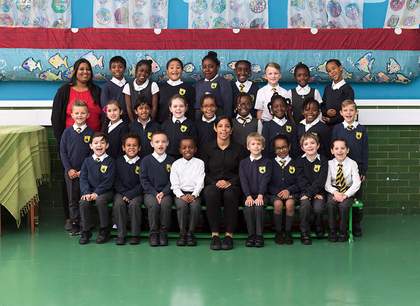
Steve McQueen Year 3 2019 Robert Fitzroy Primary Academy
© Steve McQueen. Photo: Tate
GY My last book was about all the kids that were shot dead in one day in America, and there was one boy whose mum was documented in Houston, and I sent his family the book, and his sister put the page with his name up on Facebook. Her brother had died, and she said, look, Edwin’s in a book – kind of like the authentication that he existed. It was weird; it was barely written about in the local press. And then someone came back to her on Facebook and said, oh, maybe he could write a book about Rio? And then you realise that there are other kids who have been shot who haven’t been documented. So the children involved in Year 3 going and seeing themselves in this hallowed space can’t be underestimated.
SM Year 3 is, for me, like a Trojan horse. I hope it’s going to change a lot of children’s, and also parents’, ideas of who they are and what is possible. Hopefully,it will have huge ripple effects. But I also want to say this about Tate: they took a chance on Year 3. I used to take it for granted that every child goes to museums, as I did, but this doesn’t always happen. The project has had a huge educational aspect, with a major outreach campaign to recruit and engage primary schools – with specially created learningresources and educational workshops. Tate also arranged school visits for all the pupils featured in the exhibition. So, for these children to have their first encounter with a museum, to find themselves on the walls – hats off to Tate. I know that, within that group of over 76,000 children, there’ll be some amazing artists and many amazing people in other areas – but, in a wider sense, the project could fundamentally change children’s perception of themselves and what they can achieve. And I don’t say that lightly.
GY I want to talk about how, in different ways, you tell stories. To me, Year 3 is storytelling as well as photography – it tells a story of a moment in time and place. With COVID-19 and the arts, and the debilitating effect it’s having on the ability to tell and transmit stories, you worry about the impact of COVID-19 on people going to films, going to galleries, going to the theatre. Is that something that particularly concerns you at the moment?
SM Absolutely. My main worry is that the landscape of the arts will be decimated by COVID-19. The billions of pounds the creative industries create for this country, as well as the joy and the wellbeing of the population through enjoyment of the arts cannot be undervalued. I’m hoping that there will be proper financial support for these institutions in financial crisis. It is serious. Post-COVID we might not have an arts sector to go back to in the way that it was before. And I don’t want it to become a situation where access to the arts becomes special, or only for the privileged few. We can’t allow that to happen.
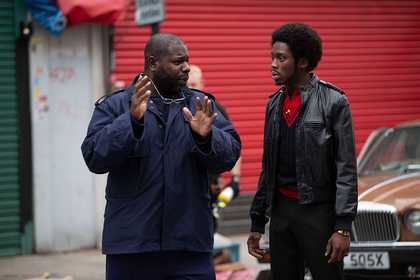
Steve McQueen with actor Sheyi Cole on the set of Small Axe, Alex Wheatle 2020
© Steve McQueen, courtesy BBC
GY If art saved you… then I would imagine you would have a particular relationship to the decimation of a sector that effectively was your salvation.
SM It gave me possibilities. It gave me a space to think in a way that wasn’t offered to me at school. The fact that there were other ways to think and other ways to see things; that excited me.
GY I want to end with a big question. Year 3 was a hopeful project; anything that suggests a future that isn’t bleak is hopeful. This project with these kids – their daffy smiles, their goofiness and their relative innocence – the sense of possibility that you mentioned is enshrined in those pictures. Do you have the same sense of hope now, a year later – given the year we’ve had? If you do, what are the sources of that hope?
SM I think George Floyd didn’t die in vain. COVID-19 is linked to climate change, to how we treat each other, how we look at health, wellbeing, morality, human rights, not to mention the outcome of the US election. I think this has been a seismic point in the history of the world.
And there’s no going back. We have the power now to demand, to recognise and to voice things. The most interesting thing about this year was when people found their voices – people who had been silent before, who didn’t think anyone would listen to them, were speaking. It’s incredible. It goes all across the board, not just with regard to racial issues. For the first time, people have felt that they could say what they feel and be listened to. I’ve never seen that before. We have come to a point in the history of the world that, with our moral conscience and recognition of the challenges we face with climate change, things can never go back.
GY Steve, I want to thank you for your voice and for telling stories that we can then take with us and use to sharpen our own voices. My daughter was in year two when your project went up; she’s in year three now – and sees her future. The fact that these conversations were taking place among ordinary people – ordinary people talking about a work of art that included them – is a real gift.board, not just with regard to racial issues. For the first time, people have felt that they could say what they feel and be listened to. I’ve never seen that before. We have come to a point in the history of the world that, with our moral conscience and recognition of the challenges we face with climate change, things can never go back.
GY Steve, I want to thank you for your voice and for telling stories that we can then take with us and use to sharpen our own voices. My daughter was in year two when your project went up; she’s in year three now – and sees her future. The fact that these conversations were taking place among ordinary people – ordinary people talking about a work of art that included them – is a real gift.
Steve McQueen Year 3, Tate Britain, until 31 January. Curated by Clarrie Wallis, Senior Curator of Contemporary British Art and Nathan Ladd, Assistant Curator, Contemporary British Art, Tate Britain. Produced by Erin Barnes and Gemma Clarke. Outdoor exhibition curated by James Lingwood, Co-Director, and Cressida Day, Managing Director, Artangel. A partnership between Tate, Artangel and A New Direction with collaboration from media partner BBC London and film partner Into Film. Supported by Joseph and Abigail Baratta, De Ying Foundation and Bloomberg Philanthropies, with additional support from Dana and Albert R. Broccoli Charitable Foundation, The Garcia Family Foundation, Wagner Foundation and Tate Americas Foundation.
Steve McQueen is an artist and filmmaker based in London and Amsterdam.
Gary Younge is a journalist, author, broadcaster and professor of sociology at the University of Manchester.

